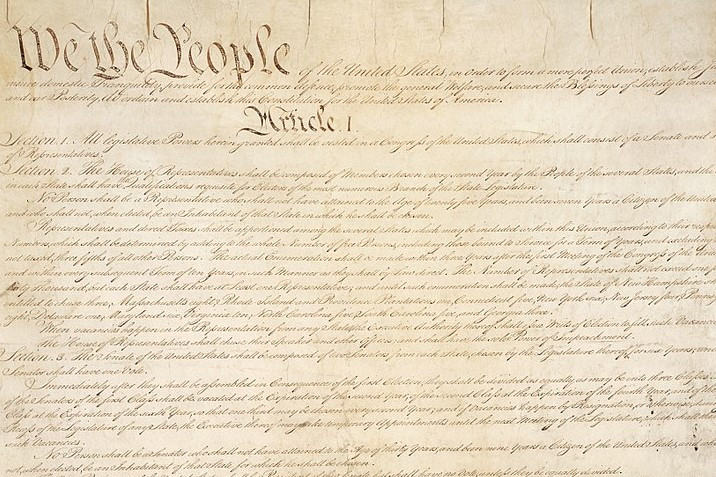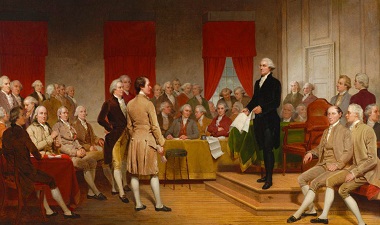Federalism
Jeffrey S. Sutton explains that federalism is a singular question in American history with a debate that never goes away.

Federalism is a question, not an answer. It is indeed the singular question in American history: When should the American people address a policy problem with a local or a national answer? It’s the one debate that never goes away. Pick any decade from 1776 onwards, and it reappears, just clothed in a new contest about a new policy imperative. No matter whether it’s novel policy challenges about public education, criminal law, civil liberties, taxation, public safety, privacy—anything and everything that affects the common good—Americans must figure out whether good government demands a local or a national response or some combination of the two.
That federalism is a question, not an answer, may explain why Americans have such a hard time grasping it. We understand democracy, representative government, states, presidents, courts, and legislatures. But not federalism. If you doubt me, try casually inserting the word federalism into your next conversation with friends. Be prepared to see eyes glaze. The word lacks a common sense because the concept lacks a fixed meaning. It is a little bit of this and a little bit of that—sometimes a state solution, sometimes a national solution, sometimes a cooperative solution.
In addition to shifting shape, the concept doesn’t seem to add up. How could two sovereigns regulate the same people in the same place at the same time? The idea of separating the powers of one government between a President, the Congress, and the federal courts comfortably registers with all of us. But the idea of giving two governments power over the same place—the power, say, to regulate Ohioans in two different ways—puzzles us and, in truth, initially puzzled the Framers.
To understand American government, however, requires an understanding of American federalism. It was the Framers’ key innovation in writing the Constitution in Philadelphia in 1787, and it was the central compromise that allowed thirteen skeptical states to ratify the Constitution in 1788. How did the compromise work? In one direction, the new Constitution gave the national government sufficient power to unify the country and to function on a day-to-day basis. This approach was in marked contrast to the failed Articles of Confederation, which essentially operated as a treaty between thirteen independent sovereigns. In the other direction, the compromise gave the national government only those powers specifically delegated to it, leaving all other powers to the states. When the Framers “split the atom of sovereignty,” in Justice Kennedy’s revealing words, they found a way to pull together thirteen disparate colonies suffering under the ineffective Articles of Confederation and unleashed a new experiment in government. From then to now, that experiment continues to unfold with fresh answers to America’s evergreen question: When should the same community of people resolve their policy disagreements at the local level or national level or some mixture of the two?
Look at the language and structure of the U.S. Constitution to capture the Framers’ vision and to see how they implemented it. Federalism required the branches of the national government created by the new Constitution—legislative, executive, judicial—to balance national and local power from the outset.
Article I creates a national legislature—Congress—with far more power than the hapless legislature created by the star-crossed Articles of Confederation. But, at the same time, it grants Congress just limited and enumerated powers—say, the power to regulate commerce, to create a post office, to be responsible for a national defense, to name a few of several dozen. Everything else is left to the state legislatures and the people.
Article II creates a head of the executive branch, the President. But that office has limited and enumerated powers as well. The President leads the branches of the military, may veto proposed legislation, implements federal programs, and enforces national civil and criminal laws. But the Framers left the enforcement of state laws and other executive-branch powers to state governors. That explains why most criminal prosecutions in this country occur at the local, not the national, level—by a ratio of roughly 250 local criminal prosecutions for every one federal prosecution.
Article III creates one Supreme Court and permits Congress to create the lower federal courts, as it immediately did after the people ratified the Constitution. A national court system unifies interpretations of the U.S. Constitution and federal statutes and, if need be, checks the elected branches of the national and state governments when they exceed their powers. Thanks to life tenure, federal judges can interpret the U.S. Constitution and enforce its provisions without fear or favor. Again, however, a bedrock allocation of federal and state judicial power remains. The state courts, then and now, resolve most civil and criminal cases—by a margin of roughly 150 state cases for every one federal case.
Other features of the U.S. Constitution directly respect and protect local power. In most instances, the Electoral College ensures that a majority of states, not just a majority of citizens, have a role in selecting the President. The Senate’s equal representation of two Senators per state, regardless of population, gives all states an equal voice in one half of the national legislature. Any change to the Constitution requires broad consensus in the states—ratification by three-quarters of them—making it difficult for future generations to drastically shift the balance between state and national power. While these provisions sometimes undervalue the preferences of a majority of Americans at a given point in time, they preserve the influence of states at each turn, no matter the politics of the moment. Through it all, as James Madison observed in Federalist No. 51, this complex system of checks and balances serves the imperative that “ambition must be made to counteract ambition,” federalism’s key contribution being the Constitution’s vertical push and pull between state and national power.
No doubt, the balance of power between the national and state governments has evolved over time, often through amendments to the U.S. Constitution. Some of the early amendments favored state power. The Bill of Rights, ratified in 1791, limited only the national government, not the state governments, for roughly a century and a half. The last provision of the Bill of Rights, the Tenth Amendment, clarified that the “powers not delegated to the United States” would be “reserved to the States” or to “the people.” The Eleventh Amendment, ratified in 1795, affirmed the principle that individuals could not sue the states in federal court without their consent. Americans occasionally looked to resolve an issue nationally but then changed their minds. Take Prohibition, in which Americans sought a national end to the sale and consumption of alcohol with the ratification of the Eighteenth Amendment in 1920. But, thirteen years later, they reversed course, returning the issue to local control with passage of the Twenty-First Amendment and giving the states the power to regulate alcoholic beverages however they wished.
At other times, more often in fact, the people have amended the Constitution to give more power to the national government. The Sixteenth Amendment authorized Congress to impose a national income tax. The Seventeenth Amendment permitted the direct election of U.S. Senators, a development that curtailed the existing power of state legislators to pick their Senators. The Nineteenth Amendment nationalized the right of women to vote by barring any contrary local laws. And the Twenty-Sixth Amendment nationalized the right to vote of those 18 and over.
Surely one of the most prominent increases in national power arose from our tragic efforts to come to grips with slavery and racism. In the beginning, the Constitution largely left these issues to local control. It apportioned seats in the House of Representatives according to population, counted by “the whole Number of free Persons” and “three fifths of all other Persons.” It also demanded that one state return an enslaved fugitive who had fled to another state, no matter what the local laws said. The Constitution otherwise left it to the states to determine whether one human being could own another. Exemplifying this approach is the Supreme Court’s justly vilified decision in Dred Scott v. Sandford, which declared African Americans non-citizens, invalidated the Missouri Compromise’s prohibition on slavery above the 36th parallel, and set the states on a collision course toward the Civil War.
When the United States emerged from the Civil War, national solutions took center stage. The Thirteenth Amendment abolished slavery. The Fourteenth Amendment barred racial discrimination by the states. Eighty-nine years after Confederate General Robert E. Lee surrendered at Appomattox, the Supreme Court in Brown v. Board of Education facilitated the end of racial apartheid by holding that the Fourteenth Amendment’s commitment to the “equal protection of the laws” could not co-exist with racially segregated public schools. The Fifteenth Amendment gave citizens the right to vote regardless of race. The President sometimes played a role in enforcing these guarantees, most notably when President Eisenhower used the National Guard to enforce Brown and the Supreme Court upheld his efforts in Cooper v. Aaron. Congress did its part as well. Among other landmark laws, the national legislature deployed representative democracy to enact (1) the Civil Rights Act of 1964, which barred discrimination based on race, faith, and sex in a whole host of areas, and (2) the Voting Rights Act of 1965, which barred racial discrimination at the polling booth. In each of these settings, the national government played a critical role.
The story of America’s quest to respect civil rights might leave the impression that only the national government has a role to play in protecting our liberty, equality, and property. That would be a mistake. Federalism creates two sources of government authority over every American and two limits on that authority. The state constitutions, no less than the federal constitution, contain myriad limits on government power. In reality, the first state constitutions, written between 1776 and 1787, initially created the many rights that Americans have come to take as their birthright: freedom from limits on speech and religion; freedom from unreasonable searches and seizures and cruel and unusual punishment; rights to a jury trial; the right to due process before any deprivation of liberty or property; and many other rights. Whenever a state or local government impinges any of these rights, the American citizen potentially has two sources of constitutional protection: the national constitution and the citizen’s state constitution. Never forget that the American story about liberty, property, and equality has a cast of fifty-one: the federal government and the states.
Why, one might wonder, would state constitutions give more protection to individual rights than the United States Constitution? Sometimes the state guarantees have distinct language. Different words can lead to different interpretations—and more rights-protective interpretations. Sometimes the state guarantees have distinct backgrounds. American federalism allows state courts to customize the meaning of their state constitutions’ individual rights to account for their unique histories, cultures, and values, something the United States Supreme Court cannot do. Sometimes the federal courts under-protect rights due to the scope of their jurisdiction or the difficulty of using one court system to fix a problem with many moving parts. The state courts face no such predicament in construing their own constitutions to fix a local problem, allowing them to fill gaps left by the federal courts with solutions uniquely suited to place, time, and circumstance. Sometimes the federal courts use one method of constitutional interpretation (say fixed meaning) in resolving a case over another (say evolving meaning). Nothing prevents the state courts from embracing a different method of interpretation, one that may lead to more (or less) protection of individual rights under the counterpart state guarantee. Perhaps most fundamentally, the general language of constitutional provisions, whether state or federal, creates reasonable grounds for disagreement about their meaning, making multiple interpretive communities all the more valuable. It should not be surprising when broadly phrased constitutional guarantees—like “unreasonable searches and seizures,” “cruel and unusual punishment,” “free speech,” “equal protection,” “due process,” and “free exercise”—receive different interpretations in the state and federal courts.
All of this calls to mind another virtue of American federalism. It allows “a single courageous State,” in the prescient words of Justice Louis Brandeis, to serve as a “laboratory” and “try novel social and economic experiments without risk to the rest of the country.” Whether it is a state legislature’s experimentation with a policy initiative or a state court’s experimentation with a new individual right under its constitution, they all permit local innovation. One test run by one state may set the stage for a solution that attracts a following in other states. It may set the stage for an idea that Congress or the U.S. Supreme Court eventually adopts for the whole country. Or it may set the stage solely for a local solution to an eminently local problem. In all events, federalism permits trial and error at the local level without the risk that a single error will put the whole country at risk.
American federalism, like breathing, often happens without our noticing it. Everyday life is permeated with examples of local government and local solutions—with overlays of federal power. States retain authority over how (and whether) to lay taxes and how (and whether) to spend the revenues they collect. The federal government does the same. That leaves us with 51 tax systems, as April 15th reminds us each year. When it comes to crime, states play the leading role, but the federal government has enacted plenty of criminal laws, too. Some states may choose to punish something severely (like the distribution of some drugs, say marijuana ), while other states allow such sales ubiquitously. The federal government sometimes enforces such laws and at other times develops ambivalence about their enforcement. States vary widely in how they address difficult public problems such as educational policy, environmental regulation, and election administration. Even public-health measures, as the COVID-19 pandemic brought to the fore, reflect distinct state-by-state approaches to balancing individual liberty against collective welfare, all with the backstop and occasional input of the federal government.
By way of conclusion, let’s return to something all Americans understand—our individual constitutional rights—and the role of both the state and federal constitutions in protecting them. Under American federalism, there are three types of stories, not just one, when it comes to our country’s constitutional protection of individual rights.
Under one story, the U.S. Supreme Court uses the U.S. Constitution to resolve a national problem. Brown v. Board of Education, for example, brought a necessary, and national, end to the much-lamented Jim Crow chapter of American history. In doing so, it fixed one of its most conspicuous mistakes—Plessy v. Ferguson—in which the U.S. Supreme Court had initially taken the view that racial segregation was a matter for local governments to handle however they wished.
A second type of story arises from a dialogue between the states that eventually leads to a national solution. The right to counsel, recognized by the U.S. Supreme Court in Gideon v. Wainwright in 1963, did not come out of nowhere. By 1963, the vast majority of states—all but five of them—already recognized such a right. Paying attention to the encouraging experiences from these local experiments, the U.S. Supreme Court could comfortably nationalize a solution to a critical imperative: that each American citizen would have legal representation before they faced the ultimate risk to liberty, a jail sentence.
In the third story, local solutions to local problems remain the order of the day. Whether it is because the problem defies a national solution or because the problem has generated several useful solutions, the resolution remains local—and happily so. We should not be surprised that a country this large, with so many people living in so many different places and under so many distinct circumstances, will not always be able to identify one unified constitutional right to handle some problems. Variation in conditions sometimes aptly leads to variations in constitutional solutions, particularly when one overriding answer to the policy problem never emerges.
As federalism is a question rather than an answer—in truth many questions and answers—our future is apt to be as difficult to predict as our past. The perennial American debate—whether to resolve our problems locally or nationally or cooperatively—will continue to manifest itself in new ways and lead to a range of new answers. While the Framers of the United States Constitution could not have anticipated the many challenges the future would bring, they exercised remarkable insight in giving future generations a marvelous tool—American federalism—for handling those challenges. Whatever the future arc of American constitutional law and American policy, it will surely benefit from 51 voices rather than just one.
Jeffrey S. Sutton is Chief Judge, United States Court of Appeals, Sixth Circuit.







